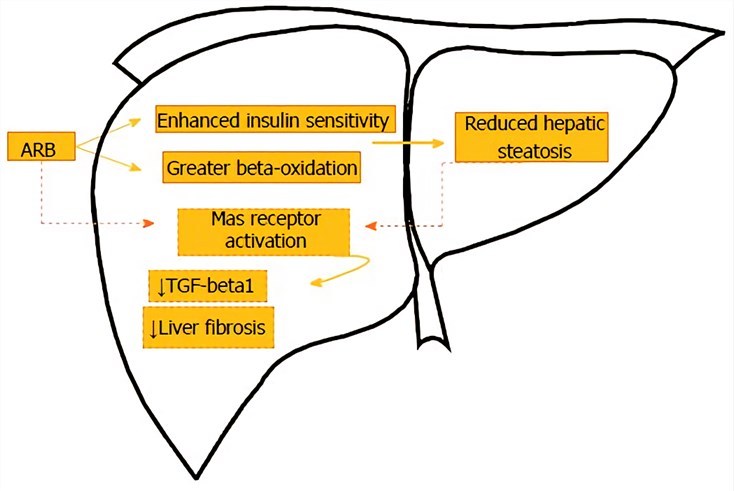NASH Target Development Service for AT1/ACE
Angiotensin-1 receptor blockers and angiotensin-converting enzyme inhibitors play an important role in the fibrosis of non-alcoholic steatohepatitis (NASH) and are expected to be therapeutic agents for improving liver fibrosis. With the extraordinary experience in drug discovery programs, Creative Biolabs is offering comprehensive target identification for drug discovery and drug development services to help you accelerate your research program and significantly increase your chance of reaching success.
Introduction of Angiotensin type 1 Receptor, Angiotensin Converting Enzyme (AT1R/ACE)
The renin-angiotensin system (RAS) is a key mediator in the regulation of the arterial blood pressure and body fluid homeostasis. In addition, RAS also plays an important role in the regulation of the local hemodynamics in several organs. In RAS, renin converts angiotensinogen into angiotensin I (Ang I), which is converted into angiotensin II (Ang II) by angiotensin-converting enzyme (ACE). Ang II mediates biological responses through two G-protein coupled receptors, Ang II type 1 receptor (AT1R) and Ang II type 2 receptor (AT2R), however, AT1R mediates most of the Ang II-induced biological effects, such as the regulation of blood pressure, salt and water retention, hormone secretion, renal function, as well as the autocrine and paracrine effects of Ang II on cell proliferation, migration and extracellular matrix (ECM) formation. In addition, the interaction between Ang II and AT1R appears to play a key role in the fibrosis of some organs, such as the lungs and liver. Ang II inhibitors such as ACE inhibitors (ACEI) and ATIR blockers (ARB) have been shown to exert anti-fibrotic effects at clinically applicable doses, which may provide new strategies for anti-fibrotic therapy.
Angiotensin Type 1 Receptor, Angiotensin Converting Enzyme (AT1R/ACE) for NASH Treatment
Among the causes of nonalcoholic steatohepatitis (NASH), hepatic fibrosis and its end-stage symptoms (cirrhosis and liver cancer) are major causes of morbidity and mortality throughout the world, and their prevalence is rising. Hepatic fibrosis is characterized by an overall increase in matrix protein concentration in liver tissue, including collagen, elastin, glycoproteins, proteoglycans, and hyaluronan, all of which can contribute the ability to alter the matrix composition profile. The most prominent producers of ECM are hepatic stellate cells (HSCs) and especially Kupffer cells (KCs), which are fundamental in the development of liver fibrosis. HSCs are a major fibrogenic cell type in the liver and play a key role in liver fibrosis. Binding of Ang II to AT1R on the surface of HSCs induces HSCs activation and increased expression of transforming growth factor-β (TGF-β). Activated HSCs secrete ECM components and TGF-β stimulates the synthesis of ECM proteins, leading to the development of liver fibrosis. Moreover, Activated HSCs also express several cytokines that accelerate liver inflammation. Based on these findings, AT1R blockers (ARB) or ACE inhibitors (ACEI) have been developed to treat liver fibrosis. They significantly attenuate experimental liver fibrosis along with suppression of the activation HSCs. In particular, ARB, such as losartan, can alleviate liver inflammation and fibrosis in NASH patients and also can improve insulin resistance, hepatic steatosis and decrease TGF-β expression. Therefore, ARB and ACEI are considered to be very promising therapeutic targets for treating fibrosis in NASH.
 Fig.1 Overview of angiotensin receptor blockers actions on the liver. (Souza-Mello, 2017)
Fig.1 Overview of angiotensin receptor blockers actions on the liver. (Souza-Mello, 2017)
ARB and ACEI have beneficial effects on liver fibrosis in NASH and are therefore important targets for NASH therapy. With extensive experiences and advanced platforms, Creative Biolabs offers all NASH-related small molecule antagonist synthesis services, such as ARB and ACEI. In addition to NASH-related services, we also provide drug discovery (including Hit to Lead, Lead Optimization, IND-Enabling, Target Identification and Validation, Hit identification) and antibody development services (including Phage Display & Antibody Library Services, Antibody Analysis Services, Antibody Engineering Services) based on other diseases. Our service platform is a cost-effective option for you to accelerate the development of drug targets. If you need any service about NASH, please feel free to contact us.
Reference
- Souza-Mello, V. Hepatic structural enhancement and insulin resistance amelioration due to AT1 receptor blockade. World Journal of Hepatology. 2017, (2):13-18.
 For Research Use Only.
For Research Use Only.